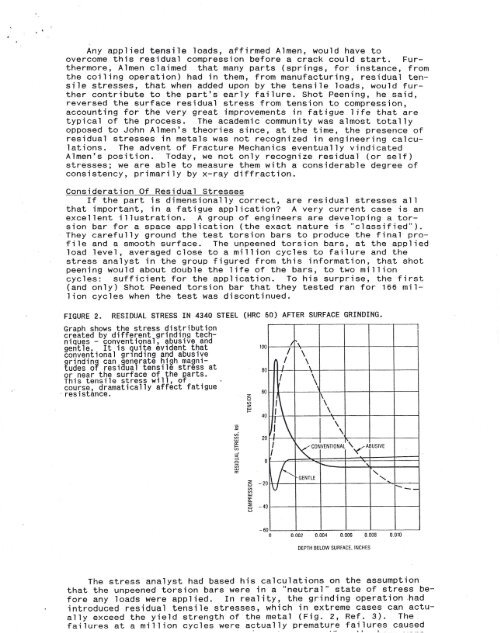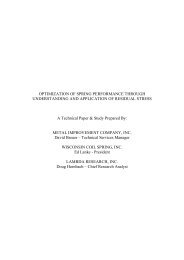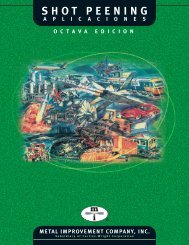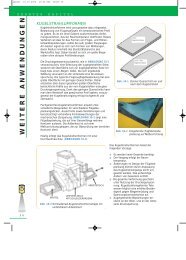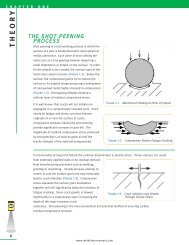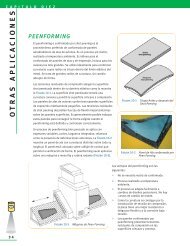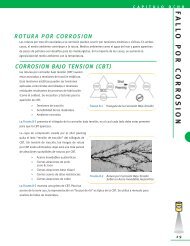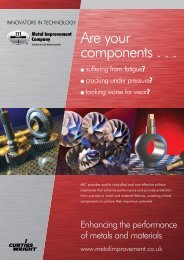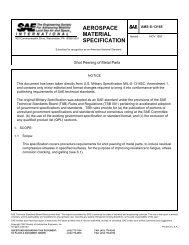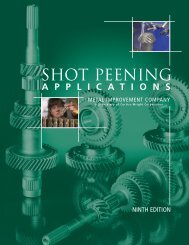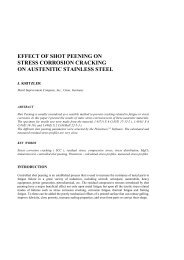Stress-lite Shot Peening of Compressor Reed Valve Components
Stress-lite Shot Peening of Compressor Reed Valve Components
Stress-lite Shot Peening of Compressor Reed Valve Components
You also want an ePaper? Increase the reach of your titles
YUMPU automatically turns print PDFs into web optimized ePapers that Google loves.
Any applied tensile loads, affirmed Almen, would have to<br />
overcome this residual compression before a crack could start. Furthermore,<br />
Almen claimed that many parts (springs, for instance, from<br />
the coiling operation) had in them, from manufacturing, residual tensile<br />
stresses, that when added upon by the tensile loads, would further<br />
contribute to the part's early failure. <strong>Shot</strong> <strong>Peening</strong>, he said,<br />
reversed the surface residual stress from tension to compression,<br />
accounting for the very great improvements in fatigue life that are<br />
typical <strong>of</strong> the process. The academic community was almost totally<br />
opposed to John Almen's theories since, at the time, the presence <strong>of</strong><br />
residual stresses in metals was not recognized in engineering calculations.<br />
The advent <strong>of</strong> Fracture Mechanics eventually vindicated<br />
Almen's position. Today, we not only recognize residual (or self)<br />
stresses; we are able to measure them with a considerable degree <strong>of</strong><br />
consistency, primarily by x-ray diffraction.<br />
Consideration Of Residual <strong>Stress</strong>es<br />
If the part is dimensionally correct, are residual stresses all<br />
that important, in a fatigue application? A very current case is an<br />
excellent illustration. A group <strong>of</strong> engineers are developing a torsion<br />
bar for a space application (the exact nature is "classified").<br />
They carefully ground the test torsion bars to produce the final pr<strong>of</strong>ile<br />
and a smooth surface. The unpeened torsion bars, at the applied<br />
load level, averaged close to a million cycles to failure and the<br />
stress analyst in the group figured from this information, that shot<br />
peening would about double the life <strong>of</strong> the bars, to two million<br />
cycles: sufficient for the application. To his surprise, the first<br />
(and only) <strong>Shot</strong> Peened torsion bar that they tested ran for 166 million<br />
cycles when the test was discontinued.<br />
FIGURE 2. RESIDUAL STRESS IN 4340 STEEL (HRC 50) AFTER SURFACE GRINDING.<br />
Graph shows the stress distribution<br />
created by different grinding techniques<br />
- conventional, abusive and<br />
gentle. It is quite evident that<br />
conventional grlnding and abusive<br />
grinding can generate high magnitudes<br />
<strong>of</strong> resiaual tensile stress at<br />
or near the surface <strong>of</strong> the Rarts.<br />
This tensile stress will, <strong>of</strong><br />
course, dramatically affect fatigue<br />
.resistance.<br />
100<br />
80<br />
60<br />
40<br />
~ -20<br />
Vi<br />
en<br />
UJ<br />
a:<br />
a.<br />
1§ -4<br />
o<br />
0<br />
I<br />
/ \<br />
I \<br />
I \<br />
I \<br />
\<br />
:\<br />
\ \<br />
!\ \ \<br />
I "< CONVENTIONAL \. Y ABUSIVE<br />
I<br />
\~<br />
,V<br />
i--.<br />
"


